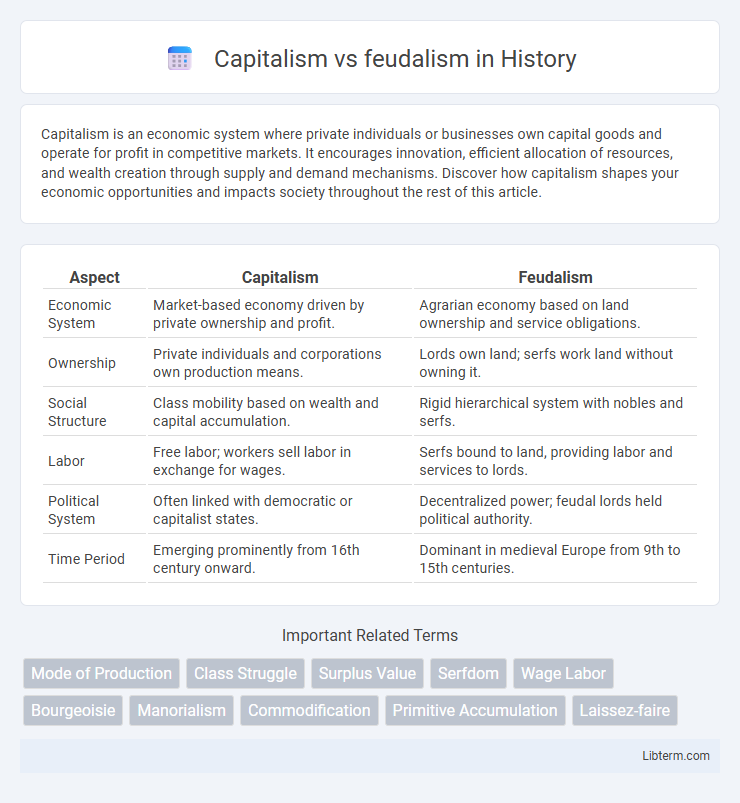Capitalism is an economic system where private individuals or businesses own capital goods and operate for profit in competitive markets. It encourages innovation, efficient allocation of resources, and wealth creation through supply and demand mechanisms. Discover how capitalism shapes your economic opportunities and impacts society throughout the rest of this article.
Table of Comparison
| Aspect | Capitalism | Feudalism |
|---|---|---|
| Economic System | Market-based economy driven by private ownership and profit. | Agrarian economy based on land ownership and service obligations. |
| Ownership | Private individuals and corporations own production means. | Lords own land; serfs work land without owning it. |
| Social Structure | Class mobility based on wealth and capital accumulation. | Rigid hierarchical system with nobles and serfs. |
| Labor | Free labor; workers sell labor in exchange for wages. | Serfs bound to land, providing labor and services to lords. |
| Political System | Often linked with democratic or capitalist states. | Decentralized power; feudal lords held political authority. |
| Time Period | Emerging prominently from 16th century onward. | Dominant in medieval Europe from 9th to 15th centuries. |
Introduction to Capitalism and Feudalism
Capitalism is an economic system characterized by private ownership of production, market-driven trade, and capital accumulation, emerging prominently during the early modern period. Feudalism, dominant in medieval Europe, is a hierarchical system based on land ownership, vassalage, and service obligations between lords and serfs. The transition from feudalism to capitalism involved shifts in property rights, labor organization, and trade dynamics, fundamentally reshaping economic and social structures.
Historical Origins and Development
Capitalism emerged in the late Middle Ages as trade expanded and mercantile activities increased, driven by market-oriented production and private ownership of capital. Feudalism, dominating medieval Europe, was based on a rigid hierarchical system of land tenure and obligations between lords and serfs, rooted in agricultural economies. The transition from feudalism to capitalism involved the decline of serfdom, the rise of urban centers, and the growth of commercial markets fostering economic innovation and social mobility.
Core Principles and Structures
Capitalism is characterized by private ownership of the means of production, market-driven economies, and wage labor systems, promoting competition and profit maximization as core principles. Feudalism relies on a hierarchical structure with land owned by lords who grant usufruct rights to vassals in exchange for service or labor, emphasizing rigid social classes and obligations rather than market transactions. The capitalist structure facilitates economic mobility and capital accumulation, while feudalism enforces agrarian-based power relations anchored in hereditary status and land tenure.
Economic Models: Ownership and Production
Capitalism is characterized by private ownership of resources and means of production, where individuals and corporations invest capital to generate profit within competitive markets. Feudalism centers on a hierarchical structure of land ownership, with lords controlling estates and peasants or serfs bound to the land, producing goods primarily for subsistence and tribute. The capitalist model emphasizes autonomous production decisions driven by market demand, contrasting with feudalism's production based on obligations and hereditary rights.
Social Hierarchies and Class Systems
Capitalism features dynamic social hierarchies driven by economic capital, where class mobility is influenced by wealth accumulation and market participation. Feudalism enforces rigid class systems rooted in hereditary status and land ownership, with limited social mobility and clearly defined roles such as nobles, vassals, and serfs. The shift from feudal to capitalist societies marks a transformation from agrarian-based social orders to industrial and market-oriented class structures.
Labor Relations and Worker Rights
Capitalism emphasizes wage labor where workers sell their labor power in competitive markets, gaining legal rights and protections such as contracts and the right to unionize, contrasting sharply with feudalism's rigid serfdom system where laborers are bound to landowners with limited personal freedoms. Worker rights under capitalism evolve through legislation and collective bargaining, fostering improved conditions and mobility. Feudal labor relations are characterized by hereditary obligations and minimal worker autonomy, restricting economic and social mobility.
Wealth Distribution and Inequality
Capitalism fosters wealth concentration through private ownership of capital and market-driven economies, resulting in significant income inequality and social stratification. Feudalism produces a rigid hierarchy with wealth concentrated in the hands of the nobility and landowners, while peasants and serfs remain economically dependent and impoverished. Both systems exhibit unequal wealth distribution, yet capitalism's dynamic markets create opportunities for upward mobility unlike the static structure of feudal estates.
Political Power and Governance
Capitalism centers political power in institutions that support market freedom, private property, and limited government intervention, promoting representative governance and rule of law. Feudalism is characterized by decentralized political authority where power is vested in local lords who control land and enforce hierarchical obligations through personal loyalty and military force. Governance in feudal systems relies on a rigid social structure with reciprocal duties, contrasting with capitalism's emphasis on individual rights and economic competition guiding political decision-making.
Impact on Innovation and Progress
Capitalism drives innovation and technological progress through competitive markets, private property rights, and profit incentives that encourage entrepreneurship and investment in new ideas. Feudalism, characterized by rigid social hierarchies and land-based wealth, restricts technological advancement due to limited economic mobility and lack of incentives for innovation among serfs and lords. The transition from feudalism to capitalism enabled broader access to resources and markets, fostering an environment where scientific discoveries and industrial developments could thrive.
Modern Relevance and Legacy
Capitalism's modern relevance is evident in its promotion of market competition, private property rights, and innovation, driving economic growth and technological progress worldwide. Feudalism's legacy persists in social hierarchies and land ownership patterns, influencing certain traditional and rural societies despite being largely replaced by capitalist systems. The transition from feudalism to capitalism reshaped political economies, leading to the rise of industrialization and modern nation-states.
Capitalism Infographic

 libterm.com
libterm.com